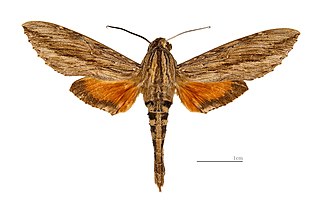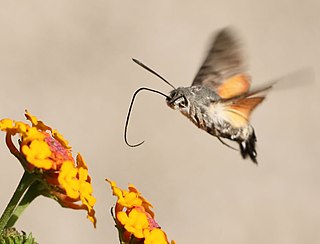
The Sesiidae or clearwing moths are a diurnal moth family in the order Lepidoptera known for their Batesian mimicry in both appearance and behaviour of various Hymenoptera.

The Hepialidae are a family of insects in the lepidopteran order. Moths of this family are often referred to as swift moths or ghost moths.

Acronicta is a genus of noctuid moths containing about 150 species distributed mainly in the temperate Holarctic, with some in adjacent subtropical regions. The genus was erected by Carl Linnaeus in his 1758 10th edition of Systema Naturae. Caterpillars of most Acronicta species are unmistakable, with brightly colored hairy spikes, and often feed quite visibly on common foliate trees. The hairy spikes may contain poison, which cause itchy, painful, swollen rash in humans on contact. The larva of the smeared dagger moth is unusually hairy even for this genus. Acronicta species are generally known as dagger moths, as most have one or more black dagger-shaped markings on their forewing uppersides. But some species have a conspicuous dark ring marking instead.

The Thyrididae comprise the family of picture-winged leaf moths. They are the only family in the superfamily Thyridoidea, which sometimes has been included in the Pyraloidea, but this isn't supported by cladistic analysis.
Pheia is a genus of moths in the subfamily Arctiinae erected by Francis Walker in 1854.

Termessa is a genus of moths in the subfamily Arctiinae The genus was described by Newman in 1856.

Acronicta impressa, the impressive dagger moth or willow dagger moth, is a moth of the family Noctuidae. The species was first described by Francis Walker in 1856. It is found from western Canada to north-western Mexico.

Dilophonotini is a tribe of moths of the family Sphingidae described by Hermann Burmeister in 1878.

Macroglossini is a tribe of moths of the family Sphingidae described by Thaddeus William Harris in 1839.
Pheia albisigna is a moth in the subfamily Arctiinae. It was described by Francis Walker in 1854. It is found in Honduras and Tefé, Brazil.
Pheia beebei is a moth in the subfamily Arctiinae. It was described by Henry Fleming in 1957. It is found in Trinidad.
Pheia daphaena is a moth in the subfamily Arctiinae. It was described by George Hampson in 1898. It is found on Dominica, Santa Lucia, Martinique, Guadeloupe and Saint Martin.
Pheia elegans is a moth in the subfamily Arctiinae. It was described by Herbert Druce in 1884. It is found in Mexico, Guatemala, Panama, Costa Rica and Venezuela.
Pheia gaudens is a moth in the subfamily Arctiinae. It was described by Francis Walker in 1856. It is found in Venezuela and Pará, Brazil.
Pheia haematosticta is a moth in the subfamily Arctiinae. It was described by E. Dukinfield Jones in 1908. It is found in Paraná, Brazil.
Pheia simillima is a moth in the subfamily Arctiinae. It was described by Rothschild in 1931. It is found in Colombia.
Pheia utica is a moth in the subfamily Arctiinae. It was described by Herbert Druce in 1889. It is found in Mexico and Panama.
The Euchromiina are a subtribe of tiger moths in the family Erebidae. It was described by Arthur Gardiner Butler in 1876. Many species in the subtribe are mimics of wasps.






